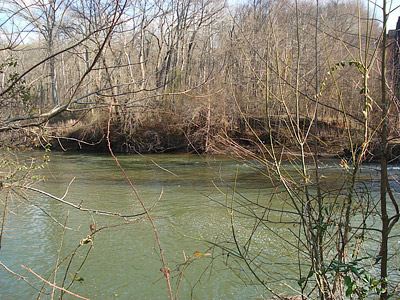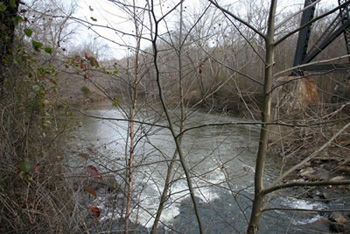Historical Clues: Onsite Inspection of the High Bridge Area

Onsite Inspection of the High Bridge Area
 Fig. 5-3: The High Bridge area photographed in early
Fig. 5-3: The High Bridge area photographed in early2008. View from north bank across the Appomattox River.
High Bridge is visible at upper right edge of photograph.
PHOTO BY Alexander M. Grabiec
An onsite inspection of the High Bridge area in January 2008 is not conclusive but does show possible signs of being the location for the battle scene depicted in Watching the Shot (Figs. 5-3 and 5-4). (5.6)
Local lore tells us that the wooden wagon bridge was washed out by a flood around 1930 and never rebuilt (5.7). During the Civil War most of the area was stripped of trees and used as farmland. Today the area has been taken over by trees and a thick tangle of brush, not having been farmed in over 75 years. Reconstruction of the railroad bridge with heavy equipment in both 1914 and 1941, have erased all evidence of the original wooden wagon bridge.
As well the topography of the river embankments, have also been leveled. Still there remain elements of the Appomattox River at this location that suggest the scene in Watching the Shot.
 Fig. 5-4: Another view of the High Bridge area
Fig. 5-4: Another view of the High Bridge area photographed in early 2008. View
from north bank. PHOTO BY Alexander M. Grabiec
The onsite inspection seems to verify the suggested distance in the painting across the river being from 75 to 100 feet across, and capable of being waded from side to side at the depth’s suggested by the painting. Although it should be noted that historical battle records show that the river was flooded to its banks when General Barlow saved the bridge, the river most likely would have receded to wading depths by the time Homer would have visited the site. Homer would have captured his scene from the north side of the river where he would have been positioned under the railroad bridge looking south. On April 6th, 1865 the CSA army was on the south side of the wagon bridge trying to get across the bridge to the north side, which is how it is depicted in the painting. The flow of the water is from west to east in the Appomattox, and this also matches the painting with the indications of water movement, around the horses and infantry men’s legs in the river. Embankments are roughly 8 to 12 feet high which generally meet the illustrated heights in the painting. Photographic imagery of the burned wooden wagon bridge as it looked immediately after the battle does not exist. However, shortly after the war the bridge was stripped of its lumber and new lumber was put down.
Watching the Shot. © 2026 All rights reserved. Terms of Use and Privacy Policy
